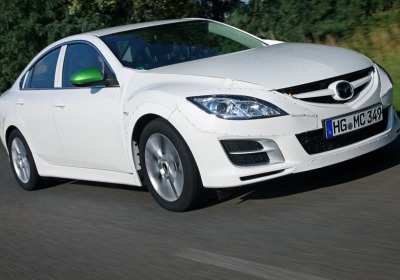Sky takes Mazda powertrains to the next level
Mon, 30 Aug 2010Mazda's next-generation of powertrains, called Sky, will feature a variety of new technologies that company engineers say improve fuel efficiency by 20 percent. The Sky engines--Sky-G for the gasoline version, Sky-D for diesel--coupled with a Sky-Drive automatic transmission or a six-speed manual, were offered for test drives during a technology day in Berlin.
The Sky-G engine we drove was a 2.0-liter inline-four that made 160 hp and 155 lb-ft of torque. Globally, the I4 engine is Mazda's main power source. With direct injection and a high-compression ratio of 14:1, the engine was smooth with impressive low-end torque, something small four-cylinder engines are not known for.
The high-compression engine features a smaller bore and longer stroke than in previous Mazda four-cylinders. A cavity in the top of the piston has been redesigned to help with the efficiency, as does a 4-2-1 exhaust system with a single catalyst.
All engine components were examined to minimize weight and rotating mass. The end result was a 15 percent reduction in friction inside the engine, Mazda engineers said.
We drove a Mazda 6 test mule--one of the same cars Mazda's European engineers are using for test purposes--fitted with the Sky-G and Sky-Drive six-speed automatic transmission and found the power delivery as advertised, smooth and linear with good low-end grunt. During a test drive that included highway driving, two-lane roads and a long run on the autobahn, the Sky-G delivered fuel economy that was 18 percent better than a Mazda 6 fitted with a non-Sky-G four cylinder.
More lock-up, less slip
The Sky-Drive automatic features a lock-up system that reduces the slippage common in a torque-converter transmission. Mazda engineers looked at CVTs and dual-clutch gearboxes during their studies but came back to the improved automatic as the better way to improve fuel economy and keep costs in line. The transmission has multiple clutches and a much smaller torque converter. The expansion of the lock-up capabilities--when there is no slippage from the torque converter--happens in every gear at 1,200 rpm and at speeds greater than 6 mph.
Mazda says the transmission shift times are quicker--just 150 milliseconds--than that of a dual-clutch box--with smoother launches and easier "creep," for when easing into a garage or parking space. The new automatic is also about 10 pounds lighter than the old six-speed.
Mazda also improved its six-speed manual gearbox, with a shorter-throw shifter--just 45 millimeters, compared with 50 millimeters in the old version--and with the elimination of one of the idle gears and other improvements, the manual gearbox is more than 20 pounds lighter than the old one.
Mazda has never been a player in diesels in the United States, but with the introduction of Sky-D, that will probably change. Mazda made no formal announcement about bringing a diesel to the United States--it sells diesels in Europe--but officials hinted that clean-diesel Mazdas could be in U.S. showrooms within 18 months.
Lower-compression diesel
While the Sky-G increased engine compression, the Sky-D reduces compression normally associated with diesels. Using piezo injectors, variable valve lift control for the exhaust and a 14:1 compression ratio, fuel economy increases 20 percent over Mazda's previous diesels. Engineers suggested 43 mpg for a diesel-powered Mazda 6. With a 5,200-rpm redline, the diesel drives more like a gasoline engine.
The 2.2-liter I4 engine is more than 50 pounds lighter than the old engine, even though it is fitted with two turbochargers--a smaller turbo, which spins up quickly and used at low rpms, and a larger turbo used for higher rpms eliminates any turbo lag. With 160 hp and 310 lb-ft of torque at 2,000 rpm, the power is impressive. The engine has a particulate filter but does not need any after-treatment to meet the stringent U.S. and European emission regulations. The lower-compression engine works at a lower temperature than previous diesels and produces less NOx and virtually no soot.
Mazda engineers also showed off body and chassis improvements that looked at every component for ways in which to trim weight while increasing strength and body rigidity.
"Our commitment is to make cars that are fun to drive," said Seita Kanai, director and senior managing executive officer for research and development. "This technology will be launched next year and will carry over through the next decade. What you see here is the drastic evolution of base technology.
"In our building-block strategy, we will use these technologies as we add i-stop, regenerative braking, hybrids, plug-ins and battery-powered EVs. But these technologies must be affordable for all customers," Kanai said.
"This is my personal opinion, not a company line, but I personally don't want to give up on the feel and sound of internal-combustion engines."
By Roger Hart



